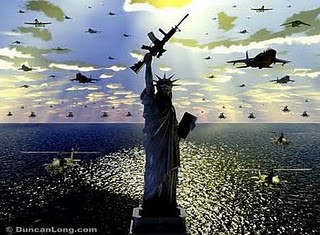In its Yearbook 2010, the Stockholm International Peace Research Institute (SIPRI) documents that the United States accounts for 43 percent of world military spending and 30 percent of global arms exports, making it preeminent in both categories.
Aggregate spending on American defense and on wars abroad is substantially larger than the official Pentagon budget and in fact may account for half of international military expenditures. [1]
In his Nobel Peace Prize address in December of 2009, President Barack Obama unabashedly celebrated his nation as the world’s sole military superpower [2], and his actions in the interim have been dedicated to confirming, prolonging and magnifying that status.
Last July it was reported that although the U.S. “is currently the world biggest weapons supplier — holding 30 per cent of the market…the Obama administration has begun modifying export control regulations in hopes of enlarging the U.S. market share, according to U.S. officials.” [3]
Obama first advocated the streamlining of arms sales controls in August of 2009 and reiterated the demand in his State of the Union address on January 27 “as an element toward doubling exports by 2015.”
The White House plan entails expediting overseas weapons transfers by establishing a single agency to oversee proposed exports.
Among what were identified as the “possible beneficiaries” of relaxed weapons export requirements is India, described at the time as “seeking 126 fighter-jets worth over $10 billion, 10 large transport aircraft worth $6 billion, and other multi-billion dollar defense sales….” [4]
Early this November the American president visited India and secured $10 billion in business transactions, an estimated half of which are in the military sphere [5], a deal that “would make the US replace Russia as India’s biggest arms supplier” and “help India curb China’s rise.” [6]
The contracts include one for India’s $5 billion purchase of ten Boeing C-17 Globemaster III military transport aircraft, “the sixth biggest arms deal in U.S. history” according to William Hartung, director of the Arms and Security Initiative at the New America Foundation. [7]
Regarding overall global arms exports, SIPRI’s calculations from earlier this year confirm that the average annual level grew by 22 percent from 2000-2004 to 2005-2009.
Russia accounted for 23 percent of sales last year, followed by the U.S.’s North Atlantic Treaty Organization allies Germany [8], France, Britain and Spain. The first five nations collectively represented 76 percent of all weapons exports in the world over the period of 2005-2009.
The largest purchasers of weapons were, in descending order, in the Asia-Pacific region, Europe and the Middle East.
Again according to SIPRI’s estimates, worldwide military spending in 2009 was $1,531 trillion, a six percent increase in real terms since the year before and a 49 percent rise over that in 2000. The U.S. and its NATO allies accounted for 70 percent of last year’s figure. [9]
Last week the U.S. Congress approved a $725 billion Defense Department authorization for 2011, in absolute dollars the largest military budget in human history and in constant dollars the largest Pentagon allocation since the Second World War.
American weapons deals abroad are of course a source of lucrative contracts for domestic arms manufacturers, but serve a more important function: The integration of scores of nations around the world into Washington’s military network.
A recent analysis in China’s Global Times detailed how the U.S. employs the sale and provision of military hardware – from firearms to armored combat vehicles, warships to warplanes and other military aircraft, missiles (including interceptors) to entire weapons systems – to advance its global geostrategic objectives:
“The Cold War political map is being redrawn. Arms sales are helping the US extend its influence in the Asia-Pacific region and pave the way for a new global hegemony.”
“After the Cold War, apart from a few rogue states, the US targeted almost every country in the world for arms sales and is also keen to sell military technology to Russia. High-tech weapons – including missile defense systems – are the main items on the list of US arms sales.”
“The US is unabashed about using high-tech weapons to expand its sphere of influence. In Europe, the US has continued to entice Eastern European countries into NATO and to squeeze Russia’s traditional sphere of influence.” [10]
With the absorption of twelve Eastern European nations into NATO from 1999-2009, Russia in fact has been driven out of the arms markets of its former Warsaw Pact allies. The development of NATO partnerships with Europe’s formerly neutral countries has also opened Finland and Sweden to the Pentagon and American weapons concerns. [11]
In 2003 Washington signed a $3.6 billion contract with Poland for 48 F-16 jet fighters which were delivered between 2006 and 2008. The sale was the largest military deal in Poland’s history. In 2006 the U.S. struck an agreement to provide Poland with five C-130 Hercules military transport planes.
RELATED ARTICLES:
Is Military Spending Saving or Enslaving?
6 Reasons To Start WWIII If You Are a Globalist


Be the first to comment on "Washington Uses Arms Sales To Achieve Global Supremacy"